On March 21, 1965, Reverend Dr. Martin Luther King, Jr. marched from Selma to Mongtomery, Alabama in order to support voting rights for African Americans. Next to him stood Rabbi Abraham Joshua Herschel, a Jewish theologian who faced Nazi perseuction and was deported. Later, he would reflect on the March, saying he felt as if his “legs were praying.”
“For many of us the march from Selma to Montgomery was about protest and prayer. Legs are not lips and walking is not kneeling. And yet our legs uttered songs. Even without words, our march was worship” Herschel said.
This image highlights the involvement of Jews within the Civil Rights Movement of the 1960s. Other rabbis and laypeople participated in the March including Rabbi William Frankel, who also experienced Nazi persecution, Barbara R. Krasner, and Joachim Prinz (Collins 2015). Krasner faced time in jail for taking part in a sit-in in North Carolina and attended the March despite being discouraged due to her gender. Prinz fled Nazi Germany in 1937 and later became involved in the Civil Rights Movement. As the President of American Jewish Congress, he helped organize and spoke at the March on Washington. Jewish leaders also joined the Freedom Riders, who rode interstate buses in order to advocate against segregation within public transportation.
Beyond the Selma-to-Montgomery March, Jews also played a role in the founding of organizations like the NAACP and the Leadership Conference on Civil and Human Rights. In 1909, Henry Moskowitz co-founded the NAACP when “an interracial group gathered…to discuss proposals for the organization that would advocate for the civil and political rights of African Americans” (NAACP).
Arnie Aronson participated in the founding of the Leadership Conference on Civil Rights, an American civil rights interest group. This organization lobbied for the Civil Rights Act of 1957 and 1964, the Voting Rights Act of 1965, and the Fair Housing Act of 1968. He also worked to push President Franklin Roosevelt to issue Executive Order 8802, which opened avenues for minorities within the federal government.
In the twentieth century, Jewish philanthropist Julius Rosenwald also contributed to the establishment of schools and 20 Black colleges. These institutions were called the “Rosenwald schools.” He also provided funding for African American housing, which helped combat segregation within Chicago.
The relationship between the two groups eventually “soured” because it “had not been tended to” (Butler 2020). Anthea Butler, a professor of religious studies and Africana studies at the University of Pennsylvania; attributed this divide to anti-Semitic slurs used by Louis Farrakan and Jesse Jackson, the diminishing influence of the NAACP; the African American Christian alliance with eveangelicals; and tensions as a result of Israel and Palestine (Butler 2020).
However, despite these tensions, Butler points out how it is important to remember how these groups helped each other during the Civil Rights Movement of the 1960s and beyond.
“Interfaith cooperation is really an important part of the Civil Rights Movement,” Butler said.

